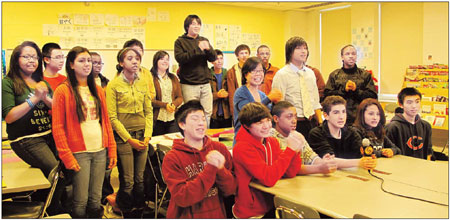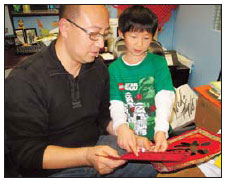China Daily Exclusive
The language of friendship
By Li Xing (China Daily)
Updated: 2011-01-20 07:59
 |
Large Medium Small |
|
Junior high students at Walter Payton College Preparatory (Public) High School learn how to say "Happy New Year!" in Mandarin. Photos by Li Xing / China Daily |
|
Qiao Bin teaches his son about this sign meaning "luck". |
Click here to see how the students say "Happy New Year!" in Chinese
The teaching of Chinese in the United States has been a road paved with difficulties. But success is finally on the horizon. Li Xing reports from Chicago.
Look, look, and look for a friend,And you find a friend;Salute and shake hands,'Cause you are my friend...
A class of 26 first graders at Alexander Graham Bell (Public) Elementary School belt out these lines aloud in Chinese. Among them, seven stand in a circle with a boy or girl dancing in the middle.
At you find a friend, one kid stops before another. In the first and second rounds, as they sing salute and shake hands they first shake hands and then raise their right hand in the American army salute.
But at a gesture from their teacher, Qiao Bin, they soon get it right.
Singing with the children, Qiao looks on with some satisfaction as everyone is clearly enjoying the traditional Chinese children's game.
"I'm using the song and the game not only to help children here learn to sing Chinese songs but also to be friends with Chinese culture," says Qiao, who has taught 5 to 9 year olds Chinese for eight years at the school under the world languages programs of Chicago Public Schools (CPS). He teaches six classes a day, five days a week, and has 400 pupils.
Qiao uses a set of textbooks titled Experiencing Chinese for elementary students.
The textbooks come from CPS's Confucius Institute, the largest and only one for elementary and high school students in the world, says Jane Lu, the institute's director and also coordinator of CPS's Chinese World Language Program.
The Experiencing Chinese series, compiled and published by the Higher Education Press in China but provided free by Chinese Hanban (the Office of Chinese Language Council International), allows children to continue pursuing Chinese through senior high school, Qiao says.
Gone are the days when Lu and a few Chinese teachers began the Chinese language program in 1999 and had to scramble for every resource to create their own syllabus and workbooks. Qiao, from a family of teachers in Shanxi province, and several other teachers, joined the CPS after clearing rigorous tests and interviews in China.
When Lu Wenya started teaching at Walter Payton College Preparatory (Public) High School 11 years ago, she was the only Chinese language teacher and had just 25 students. Now the school has hired a second Chinese language teacher, Louis Wu, to assist her, as their students now number 120.
When Li Xiaobao started teaching at Jones College Prep 10 years ago, the former college teacher of English in Xi'an found her students had been reading an English novel about China.
At that time, Jane Lu taught Chinese at McCormick Elementary School. She says she made and colored all the demo cards herself.
Qiao says he searched far and wide, including some college textbooks for inspiration. He collected small lanterns, posters of fu (character for luck), paper cuts and other arts-and-crafts pieces.
But teaching Chinese remained a big challenge.
At first, some parents complained and asked why their children should learn Chinese when they had not even learned to read and write English well, Jane Lu says. Other teachers grumbled that Chinese classes took away precious time from the courses they were teaching.
Time is a major constraint, Sandra A. Caudill, principal of Alexander Graham Bell, says. Children need daily exposure when learning a foreign language. However, since elementary schools in Chicago are limited to offering six or fewer hours of classes everyday, children at her school can only learn Chinese for 80 minutes a week.
The same is true of some high schools. Li Xiaobao says she tries to limit the after-school practice to 20 minutes every day for her students.
The best students may spend 30 minutes on Chinese at most, since they "have so much else to learn. English, mathematics and sciences are their main courses", Li says.
Despite the challenges, the teachers try various approaches and share experiences with each other in workshops organized by CPS.
At a 40-minute session in Qiao's class, first graders keep raising their hands to vie for the chance to say "this is the bird, cat, panda or elephant" in Chinese when Qiao shows them the animal pictures. They also talk about dumplings, red lanterns and children getting red envelopes of "lucky money" during the Chinese Lunar New Year.
"Apart from songs and dances and videos, I've also taken them to Chinatown so they can experience first-hand Chinese culture and our way of life," Qiao says.
In a session for junior high students at Walter Payton College Preparatory (Public) High School, Louis Wu shows slides of various sports and asks his students to demonstrate how they play basketball, football, table tennis, golf or tennis while saying aloud the descriptions in Chinese.
In another game aimed at creating the best cause-and-effect sentences, Lev Gray, Ferrin Williams and three other students take turns to scribble Chinese characters onto a small white board. They also discuss other choices and check their textbooks while erasing old words and adding new ones.
Students in three other groups are also in heated discussion.
In the end, Gray, Williams and their pals came up with the sentence, "Because he is only 8 years old, he does not drive", but look disappointed when their group doesn't win the top score.
Years of hard work have borne fruit. Some 12,000 elementary and high school students like Gray and Williams now take Chinese lessons. Williams learned some Chinese in elementary school. "I have forgotten most of what I learned then, but have now taken it up because I like the challenge of learning Chinese," Williams says.
And he is proud that he can now say, "It is a hell of a failure", in Chinese.
The teachers are also proud that some of their students have gone on to choose Chinese language and China studies either as a major or minor in college.
Jane Lu says two students have won Gates' millennium scholarships for their excellent academic achievement in Chinese language studies.
Moreover, students have discovered that learning Chinese has not affected their performance in other areas of learning. Some find that their academic performance has actually improved, Jane Lu says.
"Parents dropped their complaints and even began to help us out, such as making dresses for Chinese-language performances," she recalls.
The teachers interviewed by China Daily all say they derive the most satisfaction from their students' increasing interest in China and Chinese culture.
Qiao says his students often bring China-related items to show their knowledge about China. He has been constantly surprised by questions from his pupils, such as China's one-child family planning policy.
At Lu Wenya's first few classes, she found her students couldn't say which city was China's capital. "Some even chose Hong Kong," she recalls.
Now it's unlikely they would make the same error, she says, and they want to know more about China, raising a lot of "thought-provoking" questions, such as why students in China score better in academic tests than American students.
They also do research on ancient Chinese thinkers and other topics about China.
"Without learning Chinese, they wouldn't have had the chances to think over things about China," Lu Wenya says.
(China Daily 01/20/2011 page18)

